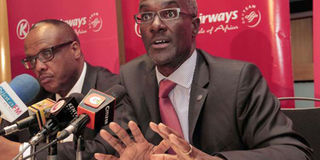National airline needs a massive dose of capital

Kenya Airways Chief Executive Officer Mbuvi Ngunze (right) at a past appearance with former Finance Director Alex Mbugua. The fresh row between pilots and Kenya Airways is threatening to derail the embattled airline’s quest to return to profitability. PHOTO | DIANA NGILA |
What you need to know:
- Management has come up with a turnaround plan based partly on selling some of the aircraft purchased recently, selling some land it owns in Embakasi and restructuring some of its crippling debt. The company has contracted the advisers, Afri-Exim Bank to do this.
- If the company were to fall deeper into debt, it could unravel all the financial models behind the massive development projects lined up by the state-owned Kenya Airports Authority, including the much-vaunted greenfield airport project.
With losses having wiped out capital and the national airline in financial dire straits, it remains to be seen how quickly the anchor shareholders of the company — the Kenya Government and KLM — will come up with a rescue package.
Negative capital exposes a company to too many risks, especially as far as creditors are concerned.
Management has come up with a turnaround plan based partly on selling some of the aircraft purchased recently, selling some land it owns in Embakasi and restructuring some of its crippling debt. The company has contracted the advisers, Afri-Exim Bank to do this.
The government recently announced it would pump Sh4.2 billion into the company while KLM is also understood to have lent undisclosed support.
While such support will come in handy in dealing with day-to-day expenses in the coming months, what the airline needs most is funding for its long-term liabilities.
Selling land, aircraft and assets is not bad. But after that, what next?
DEEP POCKETS
The priority now is commitment by shareholders on the long-term liabilities and financing the 10-year strategic plan.
The government may have to invite a strategic investor with the expertise and deep pockets to tackle short and long-term issues.
The company’s capital has been badly eroded. To assuage restless creditors, the two shareholders need to move more aggressively to make it clear that they will stand behind the airline at all costs.
The shareholders need to make it clear that they remain fully behind the company. The government needs to step in firmly because the airline’s financial health is critical to the performance of tourism and horticulture. These two are crucial for the country’s economy
With exports performing badly — the current account deficit is headed to double digit — an underperforming Kenya Airways is a prospect the administration of President Uhuru Kenyatta must be unwilling to countenance.
Kenya Airways is the de facto national airline for several countries in the region.
It has a better point-to-point connection than any other airline on the continent.
The airline’s health is also critical to the country’s ambition to be the transport and financial services hub in the region.
If the company were to fall deeper into debt, it could unravel all the financial models behind the massive development projects lined up by the state-owned Kenya Airports Authority, including the much-vaunted greenfield airport project.
Where did the rain start beating the national flag carrier?
First, an ambitious and debt-financed fleet acquisition sent financing costs skyhigh.
Worse, just as the expected growth in demand, which was the main reason for expanding the fleet was about to happen, the airline was hit by factors beyond it’s control.
These were terrorism, travel advisories and the outbreak of Ebola in its strategic West Africa markets.
The projections went belly up. “We have had turbulent times,” is how chief executive Mbuvi Ngunze described the predicament yesterday.
He is a man of faith.
Yesterday, he remained optimistic, waxing lyrical about how the fundamentals for increasing revenues were still in place.
He sited them as a new airport, more passengers and full resumption of the West African routes, and strong performance of its budget carrier Jambojet.
Chief finance officer Alex Mbugua also struck an optimistic note, arguing that although the Sh29 billion loss before tax was huge, a good proportion was due to the high disclosure and provisioning standards of accounting.
At the end of the runway, Kenya Airways needs more capital. Period.





